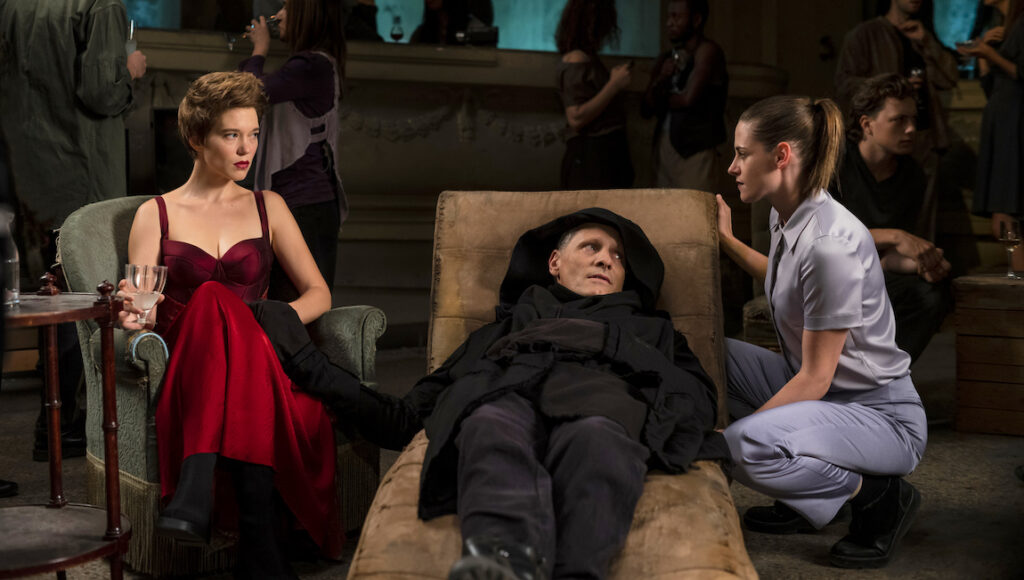Crimes of the Future is a fascinating, ambitious project from Cronenberg, who readily sources his own career-long preoccupations in the creation of something that feels startlingly new.
Our great mad scientist of orifice horror has returned after a long absence, and brought some of his old tricks with him. It’s been 8 years since David Cronenberg’s last feature film, the unfairly maligned Maps to the Stars; difficulties finding funding and a scuttled streaming project suggested the very real possibility of a forced retirement. Thankfully, this proved to be only a hiatus, and Cronenberg’s new Crimes of the Future finds him overflowing with ideas and concepts, drawing influence from his own extensive body of work while forging ahead and trying vigorously to make sense of the “now.” The film is a series of fascinating contradictions — an ostensibly futuristic setting that appears to have been filmed in old, abandoned factories and bunkers, an espionage tale that makes no sense, an emphasis on tactile, physical touch coupled with a distant, almost hollow mise en scène. Typical for Cronenberg, there’s curiosity tinged with disgust at our squishy insides, so fragile and malleable. It’s a lot to take in, and Cronenberg has no interest whatsoever in holding an audience’s hand or explaining the finer points of his bare-bones narrative. In a way, this is his Zeroes and Ones, an ambitious but alienating pandemic project from an aging iconoclast.
As for that plot; at some unidentified point in the future, mankind has begun experiencing “Accelerated Evolution Syndrome,” which results in the spontaneous manifestation of new organs inside the body and the loss of painful sensations. The film begins with a prologue of sorts, as we meet a young boy who eats plastic and is promptly smothered to death by his mother. We then turn to Saul Tenser (Viggo Mortensen), a performance artist who is apparently renowned for his ability to produce the aforementioned organs. He works with Caprice (Lea Seydoux), a former surgeon who cuts these foreign objects out of him in highly ritualized exhibits in front of a rapt audience. The duo wind up meeting two employees of the National Organ Registry, an organization run by Wippet (Don McKellar) alongside his assistant Timlin (Kristen Stewart, in a bizarre, frequently hilarious performance). Eventually, we are introduced to Lang (Scott Speedman), the father of the dead boy, and Detective Cope (Welket Bungue), who is investigating the shady underground group that Lang runs. This is all fairly vague and opaque, a series of encounters that border on the abstract. Indeed, Cronenberg seems interested in narrative only inasmuch as it allows him to convey some key philosophical ideas and display all manner of delightfully off-putting production design. Saul sleeps in a bed that looks like a womb, complete with tentacled umbilical cords that attach to his skin. There’s also a chair that looks like the skeletal remains of one of the Mugwumps from Naked Lunch, and a sarcophagus that’s actually an automated autopsy machine (shades here of the high tech device from Ridley Scott’s Prometheus, which many critics at the time considered a nod to Cronenbergian body-horror). Several themes emerge here, namely the nature of art and what it means to create, as well as what human evolution means in the face of ongoing environmental catastrophe. In other words, in a poisoned world, wouldn’t a human capable of ingesting plastic be more “fit,” in the Darwinian sense?
All of this is bandied about in long conversations that Cronenberg films mostly in singles, one person in the frame at a time, almost totally eschewing standard shot-counter-shot grammar. Wide angle lenses give the few establishing shots an off-kilter depth while flattening out interiors. It’s claustrophobic and disorienting, just skirting along the line of what a “normal” film should look like without actually confirming to that ideal. This is style stripped down to the barest minimum, Cronenberg honing in on the essence of each scene to convey an idea and tossing out the rest. Rest assured, though, there’s plenty of viscera here for those looking for wounds and flayed flesh. Echoes abound of Crash (pleasure & pain commingling), Videodrome (vaginal abdomens & old CRT TVs), Dead Ringers (the tools here resemble the gynecological “instruments for operating on mutant women”) and especially eXistenZ (a labyrinthine conspiracy plot that ultimately adds up to nothing; fleshy, squishy bio-mechanical controllers). But somehow, none of this ever feels threatening. Indeed most of the characters frequently discuss the nature of consent, so much so that when two lovers embrace under an automated slicing machine, it feels not horrific but playful, even tender. The film ends on an autopsy, the results of which might reveal the next stage of human evolution while releasing Saul from the pain of his existence. Of course Cronenberg leaves it ambiguous, choosing to linger over a cryptic smile and a fade to black. Long live the new flesh, whatever form it winds up taking.


Comments are closed.